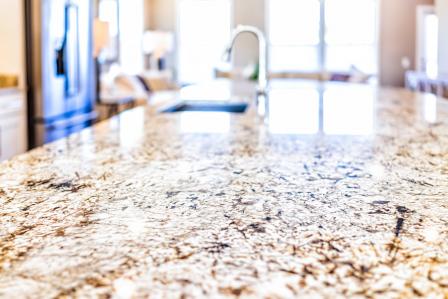Granite Countertops and Radiation
A variety of materials may be used to make countertops, including artificial materials, quartz, marble, slate and granite. Granite’s durability and decorative appearance make it a popular building material in homes and buildings.
Related information in Spanish (Información relacionada en español).
- About granite countertops and radiation
- Identifying radiation in granite countertops
- Testing the air in your home for radon
About Granite Countertops and Radiation
Did you know?
Radon originating in the soil beneath homes is a more common problem and a far larger public health risk than radon from granite building materials.
Granite, like any other stone, may contain veins of naturally occurring radioactive elements like uranium, thorium, and their radioactive decay products. These trace concentrations may vary from stone to stone, or even within a single slab of granite.
If present, uranium, thorium or radium will decay into radon, a colorless, odorless, radioactive gas that may cause lung cancer. Radon released from granite building materials can be released over the lifetime of use but typically will be diluted by ventilation.
In addition to radon, naturally occurring radioactive elements in the granite can emit small amounts of beta and gamma radiation. However, any radiation present would decrease quickly with increasing distance from the source. It is extremely unlikely that radiation from granite countertops would increase annual radiation doses above normal, natural background levels.
Use the Radiation Dose Calculator to estimate your yearly dose from sources of ionizing radiation.
Identifying Radiation in Granite Countertops
 Identifying the presence and concentration of radioactive elements in each specific granite countertop requires sophisticated instruments. These instruments require proper calibration and a knowledge and trained user to interpret the results. If you are interested in learning about testing methods, information is available from your state’s radiation protection program. Visit the Conference of Radiation Control Program Directors (CRCPD) Exit website to find the radiation program contact for each state.
Identifying the presence and concentration of radioactive elements in each specific granite countertop requires sophisticated instruments. These instruments require proper calibration and a knowledge and trained user to interpret the results. If you are interested in learning about testing methods, information is available from your state’s radiation protection program. Visit the Conference of Radiation Control Program Directors (CRCPD) Exit website to find the radiation program contact for each state.
Radon originating from the soil beneath homes is a more common problem and a far larger public health risk than radon from granite building materials. Radon is the second leading cause of lung cancer and is estimated to cause tens of thousands of lung cancer deaths in the U.S. each year. To reduce the risk of lung cancer from exposure to radon, EPA recommends testing all homes for radon and mitigating high levels, regardless of whether the home contains granite countertops. View the updated “Citizen’s Guide to Radon” for more information about testing your home.
View EPA's Frequent Questions about Radiation Protection.
Testing the Air in Your Home for Radon
To reduce the risk of lung cancer from exposure to radon, EPA recommends testing all homes for radon, regardless of whether the home contains granite countertops. Call 1-800-SOS-RADON (767-7236) or purchase do-it-yourself home radon test kits at home store retail locations, or online.
Testing is inexpensive and easy—it should only take a few minutes of your time. If elevated levels are measured, the most effective action may be to install a device that removes radon from the air in the home, rather than to remove granite countertops. View the updated “Citizen’s Guide to Radon” for more information about testing your home.
